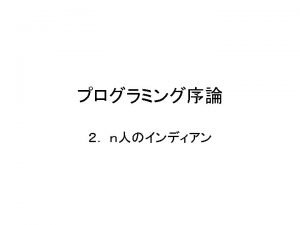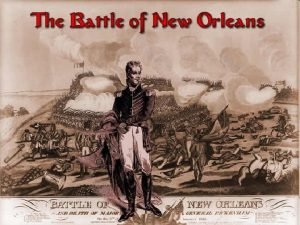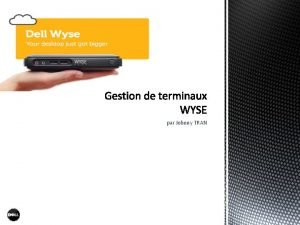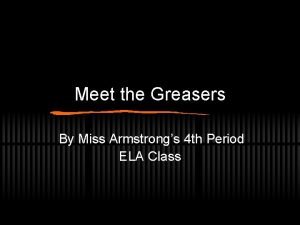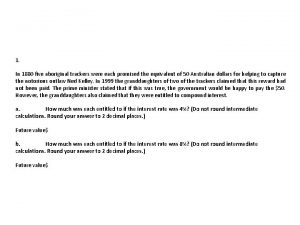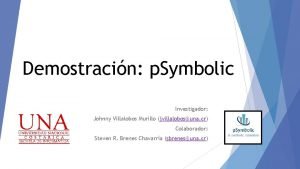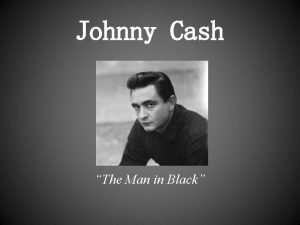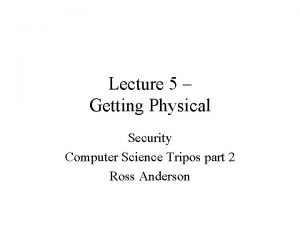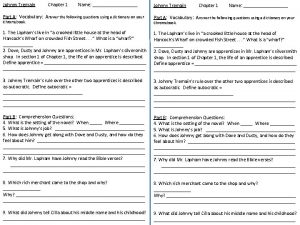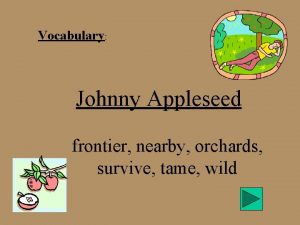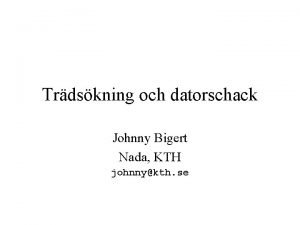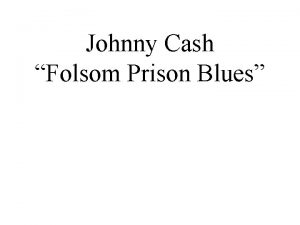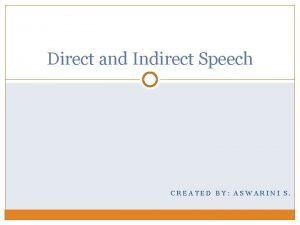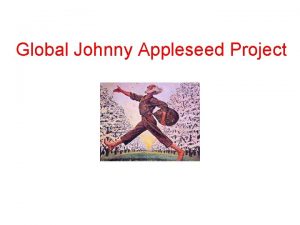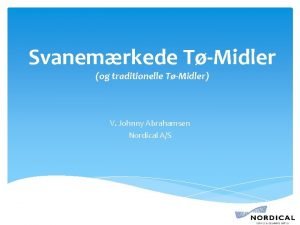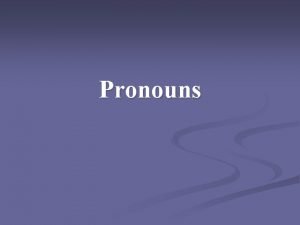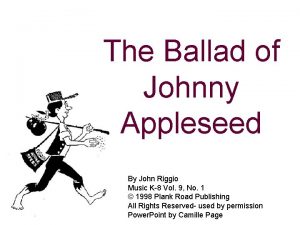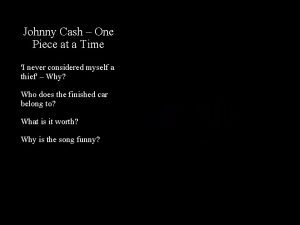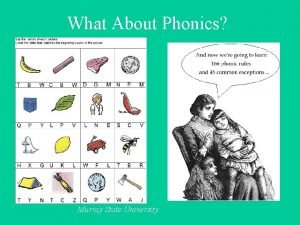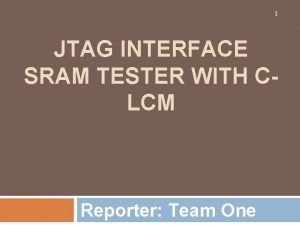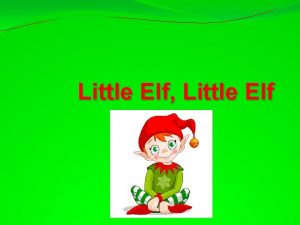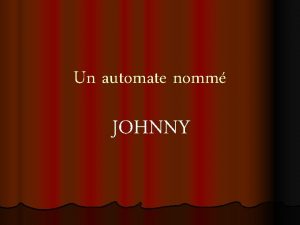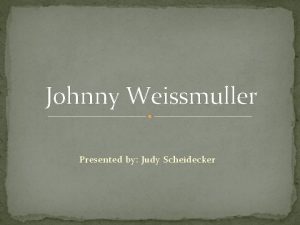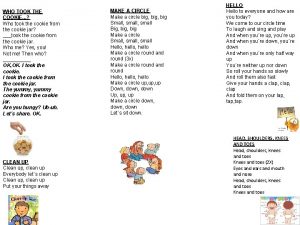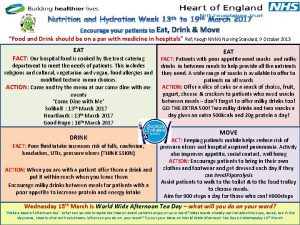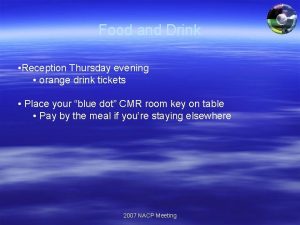Ch 9 Little Johnny took a drink Now








































- Slides: 40

Ch. 9 “Little Johnny took a drink, Now he shall drink no more. For what he thought was H 2 O, Was H 2 SO 4. ” Chemical Names and Formulas

"H-O-H"? ! WHAT'S THAT SPELL? ! mis Website: Dihydrogen monoxide Information Campaign WATER?

Naming Ions • *Element Name Search Activity* pg. 252 • Monatomic ions = ions consisting of a single atom w/a pos. or neg. charge resulting from the loss or gain of 1 or more valence electrons • Polyatomic ions = ions composed of more than 1 atom

Vocabulary CHEMICAL FORMULA IONIC COVALENT formula unit molecular formula Na. Cl CO 2

Vocabulary COMPOUND 2 elements binary compound Na. Cl more than 2 elements ternary compound Na. NO 3

Vocabulary ION 1 atom monatomic Ion + Na 2 or more atoms polyatomic Ion NO 3

Cations Metals Under aged Pb walks into a bar and the bartender turns to the gold Lose electrons Bouncer and says, “Au, get the lead Pos. charge out!” Groups 1 A-3 A sometimes 4 A When the metals in Groups 1 A, 2 A, & 3 A lose electrons, they form cations w/ pos. charges equal to their group # • The names of the cations are the same as the name of the metal followed by the word ion or cation • • • – EX: Al 3+ is the aluminum ion

Anions • • Nonmetals Gain electrons Negative charge The charge of any ion of a Group A nonmetal is determined by subtracting 8 from the group number – 7 A (7 – 8 = -1), 6 A = -2, 5 A = -3 • Anion names start w/ the stem of the element name and end in –ide – F-(fluoride), Cl-(chloride), O 2 -(oxide), S 2 -(sulfide), N 3(nitride), P 3 -(phosphide), As 3 - (arsenide)

Transition Metal Ions • Pos. charged cations w/ charges of +1, +2, or +3 • Groups 1 B-8 B • Some may form more than 1 cation w/diff. charges • Roman numeral after the metal name describes the charge OR –ous for the smaller and –ic for the larger charge • *C. P. 9. 1, P. P. 1 -2 pg. 256


Polyatomic Ions • Most names end in –ite or –ate but some end in –ium or –ide • Some begin with a H so we say Hydrogen Phosphate for HPO 4. The biprefix means: add H+ ions to the anion until its charge is -1, So H 2 PO 4 is biphosphate and HCO 3 is bicarbonate. • *9. 1 sect. assessment pg. 258

Nomenclature - Humor Fe 2+ Fe 2+ “Ferrous Wheel” Fe = iron (Latin = ferrum) Fe 2+ = lower oxidation state = ferrous Fe 3+ = higher oxidation state = ferric Ba. Na 2 “Ba. Na” What weapon can you make from the elements nickel, potassium and iron? A KNi. Fe

Naming Ionic Compounds • Binary compounds – two types of elements • Ternary compounds – more than two types of elements • Cations go 1 st – cation can be metal or polyatomic ion – For metals that have only 1 possible charge (valency, oxidation #), the name of the metal is used • Examples are Group 1 metals (1+), Group II metals (2+), Al+3, Zn+2, Ag+1 – For metals that can have more than one charge, the name of the metal is succeeded by the valency in capital Roman numerals in () parentheses OR by using the suffix –ous for the lowest valency & -ic for the highest valency

Cont… • Anions go 2 nd – neg. charged element or polyatomic ion – Neg. charged elements have the suffix –ide • Ex: oxide O, sulfide, fluoride, nitride – Polyatomic ions which include oxygen in the anion have the suffixes –ate or –ite. “ate” means there is more oxygen in the anion than one ending in “ite” 2 - and sulfite SO 2 -, nitrate NO - and nitrite NO • Ex: sulfate SO 4 3 3 2 - • Exception: OH- hydroxide • *Practice: Fe(OH)3, KNO 3, NH 4 Br, Ca(OH)2, Cu. SO 4, Cu 2 O, Al 2 S 3

Bellringer 1 (Name the following) • • • 1) Ca. Cl 2 2) PO 4 -3 3) CO 3 -2 4) Ag. Br 5) Al 2 O 3


Polyatomic Ion: a group of atoms that stay together and have a single, overall charge. Br. O 41 - Perbromate ion CO 42 Cl. O 41 IO 41 NO 41 PO 53 SO 521 more oxygen Br. O 31 - Br. O 1 - Bromate ion Br. O 21 - Bromite ion CO 32 - CO 2 - Cl. O 31 - Cl. O 21 - Cl. O 1 - IO 31 - IO 21 - IO 1 - NO 31 - NO 21 - NO 1 - PO 43 - PO 33 - PO 23 - SO 42 - SO 32 - SO 22 - “normal” 1 less oxygen Carbonate ion Chlorate ion Iodate ion Nitrate ion Phosphate ion Sulfate ion Hypobromite ion 2 less oxygen

1+ Binary Compounds H 2 3 4 Binary compounds that contain a metal 5 of fixed oxidation number (group 1, group 2, Al, Zn, Ag, etc. ), and 6 7 a non-metal. He 2+ 3+ Be B C N O F 2 Ne 3 4 Na Mg 5 Al 6 Si 7 P 8 S 9 Cl 10 Ar 13 14 15 16 Cu Zn Ga Ge As Se 17 Br 18 Kr 36 Xe 1 1 Li 11 K 1+ 2+ 12 Ca Sc Ti V Cr Mn Fe Co Ni 19 20 Rb Sr 21 Y 22 23 24 25 26 27 28 29 30 31 Zr Nb Mo Tc Ru Rh Pd Ag Cd In 32 33 34 Sn Sb Te 35 I 37 38 Cs Ba 39 40 Hf 46 47 48 49 Pt Au Hg Tl 50 Pb 51 Bi 52 Po 53 54 At Rn 78 82 83 84 85 55 Fr 56 Ra 87 88 * W 41 Ta 42 W 43 44 45 Re Os Ir 72 73 74 75 76 77 Rf Db Sg Bh Hs Mt 79 80 81 104 105 106 107 108 109 To name these compounds, give the name of metal followed by the name of the non-metal, with the ending replaced by the suffix –ide. Examples: Na. Cl sodium chlor ide (Na 1+ Cl 1 -) Ca. S calcium sulf ide (Ca 2+ Al. I 3 aluminum iodide (Al 3+ 3 I 1 -) S 2 -) 86

Practice • • • Ba. O Na. Br Mg. I 2 KCl Sr. F 2 Cs. F

Writing Formulas of Ionic Compounds chemical formula: has neutral charge; shows types of atoms and how many of each To write an ionic compound’s formula, we need: 1. the two types of ions 2. the charge on each ion Na 1+ and F 1– Na. F sodium fluoride Ba 2+ and O 2– Ba. O barium oxide Na 1+ and O 2– Na 2 O sodium oxide Ba 2+ and F 1– Ba. F 2 barium fluoride

Criss-Cross Rule Example: Aluminum Chloride Step 1: write out name with space Step 2: Al 3+ Cl 1 - write symbols & charge of elements Step 3: Al 1 Cl 3 criss-cross charges as subsrcipts Step 4: combine as formula unit (“ 1” is never shown) *ALWAYS REMEMBER TO SIMPLIFY WHEN FINISHED Al. Cl 3

Rules for Parentheses are used only when the following two condition are met: 1. There is a radical (polyatomic ion) present and… 2. There are two or more of that radical in the formula. Examples: Na. NO 31 - is a radical, but there is only one of it. Co(NO 3)2 NO 31 - is a radical and there are two of them (NH 4)2 SO 4 NH 41+ is a radical and there are two of them; SO 42 - is a radical but there is only one of it. Co(OH)2 OH 1 - is a radical and there are two of it. Al 2(CO 3)3 CO 32 - is a radical and there are three of them. Na. OH OH 1 - is a radical but there is only one of it.

Writing Formulas w/Polyatomic Ions Parentheses are required only when you need more than one “bunch” of a particular polyatomic ion. Ba 2+ and SO 42– Ba. SO 4 barium sulfate Mg 2+ and NO 21– Mg(NO 2)2 magnesium nitrite NH 41+ and Cl. O 31– NH 4 Cl. O 3 ammonium chlorate Sn 4+ and SO 42– Sn(SO 4)2 tin (IV) sulfate Fe 3+ and Cr 2 O 72– Fe 2(Cr 2 O 7)3 iron (III) dichromate NH 41+ and N 3– (NH 4)3 N ammonium nitride


Hydrates • Hydrates = ionic compounds that absorb H 2 O into their solid structures • • – Ex: Cu. SO 4. 5 H 2 O copper (II) sulfate pentahydrate – Mg. SO 4. 7 H 2 O magnesium sulfate heptahydrate C. P. 9. 2, P. P. 10 -11 pg. 263 C. P. 9. 3, P. P. 12 -13 pg. 265 9. 2 Sect. Assessment 14 -19 pg. 266 *Making & Naming an Ionic Compound Demo pg. 262

Molecular Compound A compound containing atoms of two or more elements that are bonded together by sharing electrons. Silicon dioxide, Si. O 2, is a molecular compound. It is also a mineral called quartz (left). Quartz is found in nearly every type of rock. Most sand grains (center) are bits of quartz. Glass is made from sand.


Naming Molecular Compounds • The more electronegative element is written last and w/ ide • Use prefixes to tell you the subscript in each • Mono is not written w/ the 1 st word of a compound’s name (Ex: CO 2) • Prefixes are sometimes shortened to make a name easier to say (Ex: CO is carbon monoxide not mono oxide) • Sometimes use common names instead of formal names (Ex: O 2 is oxygen not dioxygen, NH 3 is ammonia, and H 2 O is water not dihydrogen monoxide) • *Practice: N 2 O 4, PCl 5, NO 2, BF 3, NF 3, P 2 O 5, N 2 O 5, SO 2, Si. O 2, PCl 3 • *9. 3 Sect. Assessment 20 -25 pg. 270

Bellringer 2 (Write or name the following) • • • 1) N 2 O 2) lead (IV) oxide 3) Si. O 3 4) Xe. F 4 5) ammonium nitride

Writing Formulas of Covalent Molecules contain two types of nonmetals Key: FORGET CHARGES What to do: Use Greek prefixes to indicate how many atoms of each element, but don’t use “mono” on first element. 1 – mono 2 – di 3 – tri 4 – tetra 5 – penta 6 – hexa 7 – hepta 8 – octa 9 – nona 10 – deca

Writing Formulas of Covalent Molecules EXAMPLES: carbon dioxide CO dinitrogen trioxide N 2 O 5 carbon tetrachloride NI 3 CO 2 carbon monoxide N 2 O 3 dinitrogen pentoxide CCl 4 nitrogen triiodide

Practice Writing and Naming Compounds • (NH 4)2 S 2 O 3 • Ag. Br. O 3 • (NH 4)3 N • U(Cr. O 4)3 • Cr 2(SO 3)3 • iron (III) nitrate • ammonium phosphide • ammonium chlorite • zinc phosphate • lead (II) permanganate • Fe. O • Fe 2 O 3 • Cu. Br • Cu. Br 2 • cobalt (III) chloride • tin (IV) oxide • tin (II) oxide

Exceptions! Two exceptions to the simple –ide ending are the diatomic oxide ions, O 22 - and O 21 -. O 22 - is called peroxide Note the differences. O 21 - is called superoxide. barium oxide barium peroxide Ba. O _____ Ba. O 2 _____ sodium oxide sodium peroxide Na 2 O _____ Na 2 O 2 _____ potassium oxide potassium superoxide K 2 O _____ KO 2 _____ Ba 2+ Na 1+ Do Not Reduce to lowest terms! K 1+

Acids • Acid = a compound that contains one or more hydrogen atoms and produces hydrogen ions (H+) when dissolved in water. • Consist of an anion combined w/as many hydrogen ions needed to become electrically neutral in the form (Hn. X)


3 Rules to Naming Acids: • 1. When the name of the anion (X) ends in –ide, the acid name begins w/the prefix hydro-. The stem of the anion has the suffix –ic and is followed by the word acid – HCl = hydrochloric acid • 2. When the anion name ends in –ite, the acid name is the stem of the anion w/the suffix –ous, followed by the word acid – H 2 SO 3 = sulfurous acid • 3. When the anion name ends in –ate, the acid name is the stem of the anion w/the suffix –ic followed by the word acid – HNO 3 = nitric acid

Naming Bases • Base = ionic compound that produces hydroxide ions when dissolved in water • Bases are named in the same way as other ionic compounds – the name of the cation is followed by the name of the anion – EX: Na. OH = sodium hydroxide – Al(OH)3 = aluminum hydroxide • *9. 4 Sect. Assessment 26 -33 pg. 273

Formula Name? Metal + Nonmetal? (Except: NH 4+) Two Nonmetals? Ionic d, f-block Pb, Sn Multiple Columns 1, 2, 13 Ag+, Zn 2+ Single Covalent Steps 1 & 4 ONLY 1. Write name of cation (metal) 2. Determine the charge on the metal by balancing the ( -) charge from the anion 3. Write the charge of the metal in Roman Numerals and put in parentheses 4. Write name of anion (Individual anions need –ide ending!) Use Prefixes!!! *Mono* Di Tri Tetra Penta Hexa Hepta Octa Nona Deca

Name Formula? No Prefixes? Ionic Prefixes? Covalent 1. Determine the ions present and the charge on each (Roman Numeral = cation charge, otherwise use PT) 1. FORGET CHARGES!!! 2. Balance formula (criss-cross) 3. Do NOT reduce subscripts! 3. Reduce subscripts (if needed) 2. Use prefixes to determine subscripts

 Psy
Psy 1 little 2 little 3 little indians
1 little 2 little 3 little indians 1 little 2 little 3 little indian
1 little 2 little 3 little indian In 1814 i took a little trip
In 1814 i took a little trip Now i see it now you don't
Now i see it now you don't Johnny tran
Johnny tran Johnny appleseed candy
Johnny appleseed candy Dally winston physical description
Dally winston physical description Johnny's lunches is considering purchasing a new
Johnny's lunches is considering purchasing a new Manslaughter definition in the outsiders
Manslaughter definition in the outsiders Johnny bravo 1995
Johnny bravo 1995 Johnny talk ptt
Johnny talk ptt Johnny villalobos
Johnny villalobos Xkcd security
Xkcd security Johnny from the outsiders in the hospital
Johnny from the outsiders in the hospital Man in black johnny cash meaning
Man in black johnny cash meaning Physical security computer science
Physical security computer science Johnny tremain chapter 3
Johnny tremain chapter 3 Cherry valance thoughts about inner self
Cherry valance thoughts about inner self Johnny appleseed vocabulary words
Johnny appleseed vocabulary words Johnny nada
Johnny nada Johnny cash i hear the train a comin
Johnny cash i hear the train a comin Johnny brown
Johnny brown Johnny tractor y su pandilla
Johnny tractor y su pandilla John told me, “i have seen this movie.”
John told me, “i have seen this movie.” Johnny appleseed project
Johnny appleseed project Johnny r cash
Johnny r cash Bape cupcakes
Bape cupcakes Johnny abrahamsen
Johnny abrahamsen Johnny depp pronouns
Johnny depp pronouns The outsiders plot diagram
The outsiders plot diagram Johnny appleseed bag
Johnny appleseed bag 1935 born
1935 born Johnny appleseed costume
Johnny appleseed costume Cash johnny one
Cash johnny one Johnny phonics
Johnny phonics Johnny cupcakes net worth
Johnny cupcakes net worth Johnny sinze
Johnny sinze Father knows least
Father knows least Johnny cash first wife ethnicity
Johnny cash first wife ethnicity Johnny kelly family
Johnny kelly family


